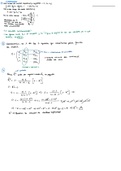Exam (elaborations)
Power EXAM BI DA-100: Analyzing Data with Microsoft Power BI(latest version)
- Course
- Institution
What are the divisions of the core components of analytics? correct answer- To analyze data, core components of analytics are divided into the following categories: -Descriptive -Diagnostic -Predictive -Prescriptive -Cognitive What are descriptive analytics? correct answer- Descriptive analy...
[Show more]




